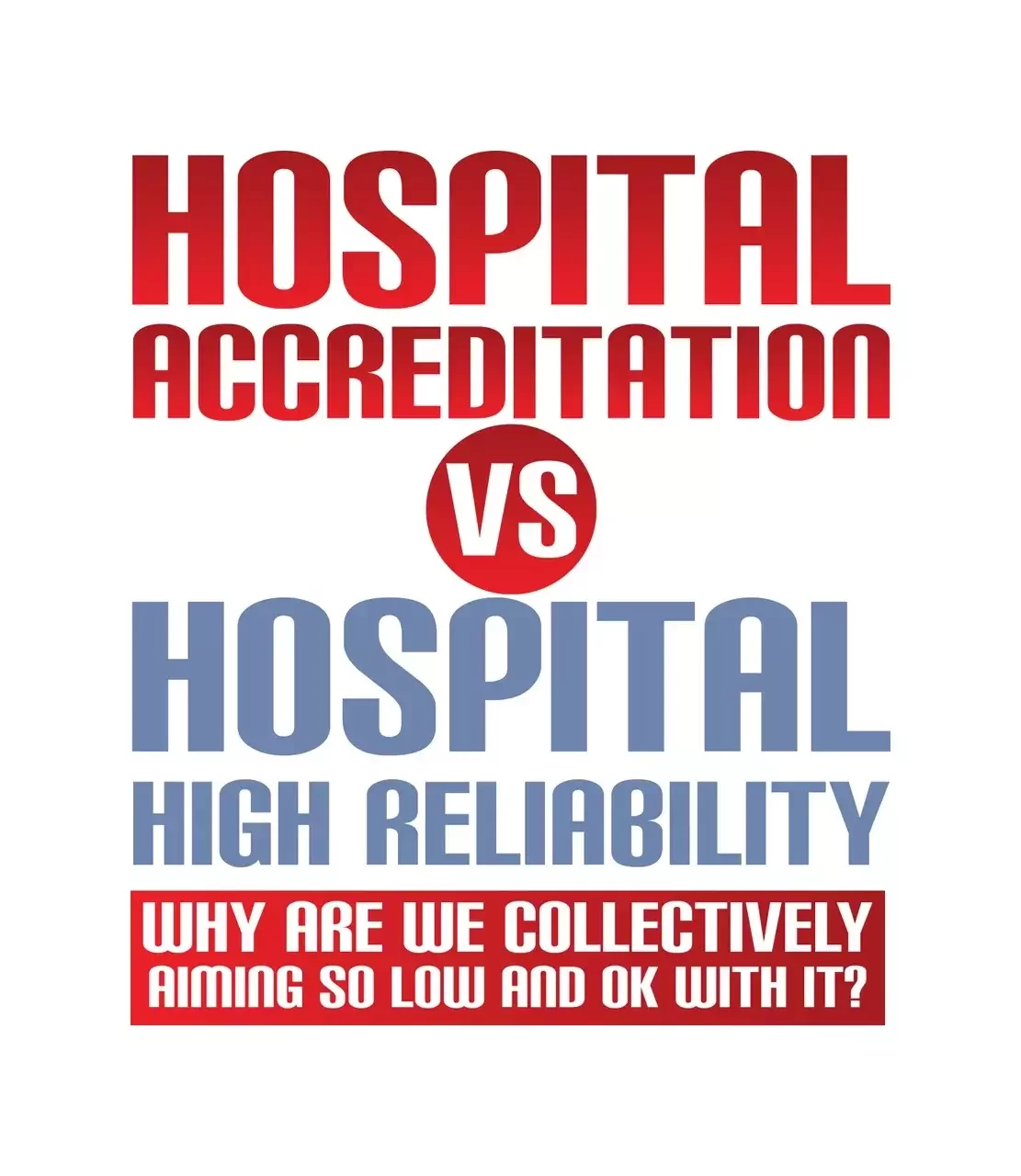
The question to ponder as you read through this article is:
“Why is accreditation often the organizational focus OVER High Reliability and Zero Harm?”
impression of why hospitals are accredited from this “survey prep mode” paradigm.
In random conversations with RN acquaintances of mine, after I mention “I help hospitals more efficiently pass TJC surveys, improve patient safety and experience, kill less people by accident, etc., etc.,” the mere mention of “The Joint Commission” or “accreditation” usually invokes a look somewhere between annoyance and pure disdain.

Upon further questioning, this is usually linked to the fact that and a lot of out-of-the-ordinary preparation is required of the staff.
This cycle unintentionally reinforces that it’s ok to be non-compliant in many areas when a survey is not due. Not to mention reinforcing negative connotations to staff and obfuscating one of the main original objectives the government had behind accreditation and granting deeming authority to organizations like The Joint Commission – patient safety and quality of care.
As for the few hospitals that don’t do well on their survey, they usually manage to scramble some more, spend a lot more money on making required improvements (or just documenting them a bit better, showing a 90%-ish compliance rate and plan for improvement…seems legit!?) and get past their conditional accreditation.

Section Summary: US Healthcare = Scramble every so often to maintain accreditation, yet accreditation has been identified as being a low bar for patient safety; nevertheless, hospital accreditation is often the primary goal.
A Gold Seal? Bronze might even be a stretch…
Moving further down my thought process that has led me to this vexed state: The Joint Commission’s Quality Check website (www.qualitycheck.org) mentions “Organizations that have achieved the Gold Seal of Approval” and “Find a Gold Seal Healthcare Organization” on its homepage.
So, every three years, a hospital earns a Gold Medal!!! It’s almost like the Olympics! Except for the part that you can “lose”, yet still eventually earn your gold medal and that you would not be able to compete in the interim window between surveys because it’s too difficult to sustain that performance.
As an industry, we continue to make accreditation the goal and many a curmudgeon would argue “this is how we have always done it.” The fact is, with this accreditation-focused mindset prevalent in US Healthcare, we are aiming for low reliability, hoping for the result of high reliability. What’s the definition of insanity again?
And we do this, yet we know what?
We know that:
- Depending on what study you look at, healthcare in the United States is responsible for the 3 leading cause of death – Medical Error. And this has been roughly well-known since 1999 when To Err is Human first threw out some large figures of harm and death mistakenly done at the hands of healthcare in the United States.
- We need a different result: zero harm.
Yet we also know:
- We currently still largely focus on hospital accreditation and have done so for many years.
- There has been very little improvement since 1999’s To Err is Human.
- Accreditation leaves substantial room for error and, thus, improvement. Accreditation standards (TJC, etc.) are relatively low bars for quality of care and patient safety.
- Once the survey is passed, the collective sigh of relief breeds complacency. “Are we still compliant with even that low bar a year after our triennial TJC survey?”
We often talk about how we need to:
- Move to a collective culture of safety, high reliability and zero harm.
But…
I’ve noticed many healthcare administrators may agree with the large medical error death figures from To Err is Human and the more recent BMJ report, but they “know” nothing like that happens at their hospital (yes, I’m poking at you administrators a little bit here).

I may have been slightly off-base with the last statement, as many healthcare leaders often have a genuine interest in high reliability, yet still have not figured out how to include it with their organizations’ other priorities. Yet, they often seem to know it sounds right to include in their rhetoric. Half of the C-Suite Q&A and interview posts on Becker’s Hospital Review have a healthcare leader saying they are “working to get to high reliability/zero harm” or “they are working to be the safest hospital in the nation.” (Ok, administrators, I’m poking at you a bit more, sorry.)
So as an industry, we have been getting our Gold Seals of accreditation for years while simultaneously being guilty of harming millions of patients due to medical error.
The “Survey Prep” paradigm is partly to blame for this.
Addressing the Skeptics
I know some skeptics of the BMJ medical error report and To Err is Human will push back on the idea of the need for transformation (do these ones live in a bubble?).
Or they may mention the outlier hospitals that have done better than most at improving patient safety. These rare exceptions have made substantial strides in improving patient safety and some may arguably be on the real road to high reliability.
A couple of examples of the outlier hospitals come to mind from what I’ve seen in online media:
- Cincinnati’s Children’s Hospital (https://www.cincinnatichildrens.org/service/j/anderson-center/safety/methodology/high-reliability)
- Memorial Hermann Health System (http://www.beckershospitalreview.com/quality/turning-healthcare-in-to-a-high-reliability-industry-memorial-hermann-shares-5-steps.html)
- Virginia Mason Medical Center (WAIT, WHAT?!)
- Was a Patient Safety Leader… https://www.virginiamason.org/body.cfm?id=158&action=detail&ref=3836
- And then this happened… http://www.beckershospitalreview.com/quality/joint-commission-denies-virginia-mason-full-accreditation-after-discovering-safety-issues.html
*Note none of these are Readiness Rounds clients.
So my response to skeptics:
There are 5,627 registered hospitals in the United States, yet only a tiny fraction of them have achieved substantial strides in the path to high reliability. Furthermore, one of those that was believed to and lauded for leading the pack, in fact, did not sustain whatever, if any, improvements they made in the past and were unable to even pass their most recent TJC survey. Another point to consider, in regards to quality, only 102 hospitals scored a "5 Star" rating with CMS's recently reworked Overall Hospital Quality Ratings.
With that being said, the first two organizations mentioned above deserve recognition for taking steps in the right direction; I know there are many healthcare organizations, some of them clients of Readiness Rounds, that are trying to move from an accreditation-focused mindset to one of high reliability.
BUT…
Accreditation is still the prevailing motivator and partly why we are still inadvertently, yet consistently, harming our patients in US healthcare.
So what is the solution? How do we get past our accreditation-only mindset?
Want additional resources?
In Closing
High reliability in healthcare is by no means an easy path to undertake. Substantial culture change has to occur and explaining the nuances of high reliability is beyond the scope of this post. But one piece other highly reliable industries have become proficient with is the use of checklists: proactively and consistently checking systems, staff knowledge, processes, protocols, etc.
If deployed appropriately and used for process improvement, accreditation becomes a byproduct and real high reliability becomes all the more achievable. Robust electronic checklists and rounding tools such as the Readiness Rounds platform allow a hospital to efficiently measure, continually improve AND sustain quality of care, patient safety and satisfaction results.
Read our 4 Musts of HRO Hospitals infographic, visually explaining the relationship a process improvement platform like Readiness Rounds has with the other musts of an HRO Hospital.
I hope this post is thought-provoking at the very least. My conclusion is until I see a follow up BMJ medical error report or “To Err is Human Part II” that says the industry has made substantial improvement in reducing medical error and harm, then I’ll keep raising my hand, ranting on my blogs, highlighting something is wrong and persuading individuals there is a better way and a solution. There is a lot of work to do and hopefully my colleagues and I at Readiness Rounds can be a positive change agent in an industry that so desperately needs it.

Thank you for reading. Please don’t be shy, feel free to comment and discuss in the comment section at the bottom of the page.
